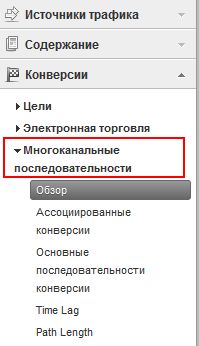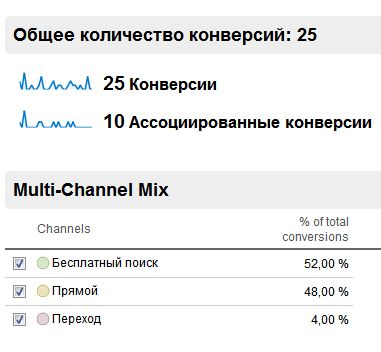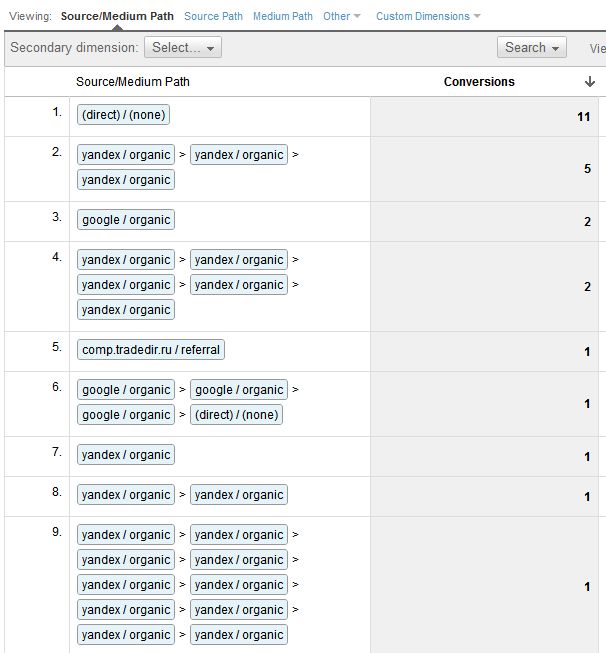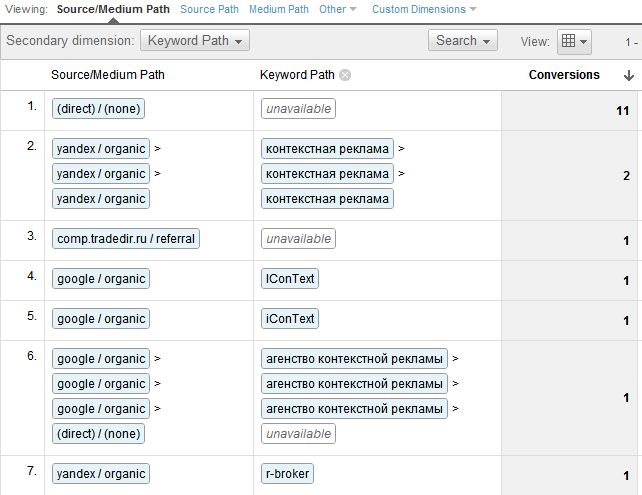New feature in Google Analytics - multichannel sequences
Not so long ago, an updated interface appeared in Google Analytics, about which my colleague Alexey Ilyin wrote here in “E-commerce”. And today a new feature has been submitted to the public - “multichannel sequences” (as usual, it is not the best translation, but there is one). In the original, this function is called “multichannel funnels”, and it is also available only in a fresh interface (and, by far, not everyone).
Immediately it is worth making a reservation that this is a “pilot” launch of a feature, and all sorts of glitches and bugs are possible - which, incidentally, is typical of all the updated Google Analytics, which cannot be fully worked out yet. While Google has not announced plans for the final launch of this functionality, but now you can see which way the company's engineers will go, and this side is certainly interesting.
So what are these multichannel sequences? In essence, this is the development of Search Funnels ideas, which have been present in AdWords for quite a long time and represent chained transition sequences for various advertising campaigns (for example, a visit to a campaign with product numbers may be followed by a transition from a brand-name campaign. conversion. In this case, you can understand that you should not give up the “articulate” campaign, as it helps to convert another campaign). Multichannel sequences work almost the same, only as if to a higher level - with their help one can trace not only the sequence of campaigns, but also the sequence of transitions from different channels / sources. The corresponding report is available in the “Conversions” section.
')

But what constitutes the simplest report in this section is the “review”.

As you can see, there is little information, but for a start it is not bad either. A little more information is contained in the following report, “Associated sequences”.

In the column “associated conversions” (in English this is called the more understandable term “assisted conversions”), how many times the source (or channel) was encountered in the sequence of visits BEFORE the conversion. Well, “last interaction conversions” are actually familiar conversions, counted with the help of last click one by one per visit.
As a result, an “assistivity” index is calculated for each source - this is a simple ratio of all associated conversions to last click conversions.

It is clear that the greater this number, the more the source “helps” conversions, and the less often it occurs at the very end of the chain of visits. The reverse is also true - the lower this indicator, the less often it occurs before the conversion, but it is converted quickly. Based on this very simple indicator, we can conclude which sources are converted faster. It is clear that you need to compare the same type of sources - for example, cpc-advertising Yandex and Google, and certainly not direct traffic with organic. If used correctly, it will be possible to understand, for example, whether the media printer helps to convert visitors to other sources, while - a known fact - it converts badly.
Even more interesting is the following report, “Basic Conversion Sequences” (phew, this is just Top Conversion Paths).

Based on this screenshot, it becomes clear how those “associated conversions” are considered. This is not very obvious, but the idea is the following: “associated conversion” (it is better to call it simply “assistant”, because there is still no conversion as such) the number of unique entries in all chains, except for entries in chains with length = 1, will be considered. . Just in case, we’ll clarify that chains without conversions are not considered here at all.
In this case, let's look at yandex / organic. He has a total of 10 last-click conversions. And associates - 9. How did this happen? Add up column 2 - there are 5 unique visits (the report shows us that there were 5 chains of three consecutive yandex / organic visits), column 4 - 2 unique visits, column 7 is skipped, since this is a chain from one visit and it ended in conversion, and finally column 9 — there is one unique occurrence of this source in it. In total, you get 9, as in the screenshot above about associated conversions.
So, “Associated Conversions” are just _unique_ occurrences of one or another source in chains with conversions, and occurrences with a length of 1 are not considered. Unfortunately, the example in the screenshot is not very indicative, since our yandex / organic was not intermingled in chains with other sources (we call such chains “homogeneous” in the internal slang without impurities).
But if you look at google / organic, which mixed in column 6 with direct / none (and the chain turned out to be “heterogeneous”), it turns out that it has 2 last click conversions (this follows from column 3), and the associated ones - 1, so as in column 3 both chains consist of one visit, and in column 6 we see one chain in which google / organic is found, but the source of direct / none led to conversion in this column. Again, exactly the same numbers as in the screenshot about the associated conversion.
An inquisitive reader will immediately draw attention to column 6 — a direct visit in it follows an organic one, which is possible in rare cases (for example, after the death of the cookie utmz). However, in this case, Google Analytics considers direct visits “honestly”, without referring to previous visits, if any. Therefore, if you count the number of visits to direct traffic in these reports, they will not converge with the report, for example, in the “Traffic Sources” section.
In general, it seems to me that these two reports - “Associated Conversions” and “Basic Conversion Sequences” - would be useful to combine them into one, for greater clarity.
By the way, with the last report you can do many more guitars - for example, add a secondary segmentation by keywords. The following will turn out:

Look at column 4 and column 5 — Google Analytics divided these chains in this report because the keywords differed in their spelling.
The other two reports - “Time Delay” and “Chain Length Before Conversion” are not so interesting, and are very similar to the standard reports from AdWords Search Funnels.
What is the result? Google Analytics has taken the first step in mastering the technology of multi-channel attribution - this new “holy grail” of web analytics, which has been underway for several years now. Unfortunately, at the moment, the presented functionality lacks the most important component, perhaps - there is no attribution model itself, that is, the importance of the source depending on its position in the chains. After all, it would be very interesting to know how much money in the cost of conversion is a banner, and how much context, for example. It is clear that there is no single model yet (a linear, logarithmic and “as God will send to the soul” are offered to choose from), and Google does not really want to impose its own.
Also, for a full-fledged multi-channel attribution of paid traffic, the new function lacks information about banner views (alas, for now it simply has no place to take it, and one can only guess whether Google engineers will be able to import it somehow), which on the other hand leaves room for activity specialized agencies.
Well, within the framework of mandatory self-praise, I would like to note that we have been conducting research on multichannel attribution for quite some time, and even created tools for quick work with similar data. We are based, however, on the basic capabilities of Google Analytics, which were before the introduction of “multichannel sequences”.
True, this whole area is not developed at all - there are no standard approaches, methods, and even terminology. However, we already have our own designations for certain phenomena - the same “assists”, “heterogeneous and homogeneous chains” and so on.
Nevertheless, I am very pleased that now a new player has appeared on this field who is able to correct the situation and put brains to advertisers and analysts in their place.
Timofey Putintsev
Immediately it is worth making a reservation that this is a “pilot” launch of a feature, and all sorts of glitches and bugs are possible - which, incidentally, is typical of all the updated Google Analytics, which cannot be fully worked out yet. While Google has not announced plans for the final launch of this functionality, but now you can see which way the company's engineers will go, and this side is certainly interesting.
So what are these multichannel sequences? In essence, this is the development of Search Funnels ideas, which have been present in AdWords for quite a long time and represent chained transition sequences for various advertising campaigns (for example, a visit to a campaign with product numbers may be followed by a transition from a brand-name campaign. conversion. In this case, you can understand that you should not give up the “articulate” campaign, as it helps to convert another campaign). Multichannel sequences work almost the same, only as if to a higher level - with their help one can trace not only the sequence of campaigns, but also the sequence of transitions from different channels / sources. The corresponding report is available in the “Conversions” section.
')

But what constitutes the simplest report in this section is the “review”.

As you can see, there is little information, but for a start it is not bad either. A little more information is contained in the following report, “Associated sequences”.

In the column “associated conversions” (in English this is called the more understandable term “assisted conversions”), how many times the source (or channel) was encountered in the sequence of visits BEFORE the conversion. Well, “last interaction conversions” are actually familiar conversions, counted with the help of last click one by one per visit.
As a result, an “assistivity” index is calculated for each source - this is a simple ratio of all associated conversions to last click conversions.

It is clear that the greater this number, the more the source “helps” conversions, and the less often it occurs at the very end of the chain of visits. The reverse is also true - the lower this indicator, the less often it occurs before the conversion, but it is converted quickly. Based on this very simple indicator, we can conclude which sources are converted faster. It is clear that you need to compare the same type of sources - for example, cpc-advertising Yandex and Google, and certainly not direct traffic with organic. If used correctly, it will be possible to understand, for example, whether the media printer helps to convert visitors to other sources, while - a known fact - it converts badly.
Even more interesting is the following report, “Basic Conversion Sequences” (phew, this is just Top Conversion Paths).

Based on this screenshot, it becomes clear how those “associated conversions” are considered. This is not very obvious, but the idea is the following: “associated conversion” (it is better to call it simply “assistant”, because there is still no conversion as such) the number of unique entries in all chains, except for entries in chains with length = 1, will be considered. . Just in case, we’ll clarify that chains without conversions are not considered here at all.
In this case, let's look at yandex / organic. He has a total of 10 last-click conversions. And associates - 9. How did this happen? Add up column 2 - there are 5 unique visits (the report shows us that there were 5 chains of three consecutive yandex / organic visits), column 4 - 2 unique visits, column 7 is skipped, since this is a chain from one visit and it ended in conversion, and finally column 9 — there is one unique occurrence of this source in it. In total, you get 9, as in the screenshot above about associated conversions.
So, “Associated Conversions” are just _unique_ occurrences of one or another source in chains with conversions, and occurrences with a length of 1 are not considered. Unfortunately, the example in the screenshot is not very indicative, since our yandex / organic was not intermingled in chains with other sources (we call such chains “homogeneous” in the internal slang without impurities).
But if you look at google / organic, which mixed in column 6 with direct / none (and the chain turned out to be “heterogeneous”), it turns out that it has 2 last click conversions (this follows from column 3), and the associated ones - 1, so as in column 3 both chains consist of one visit, and in column 6 we see one chain in which google / organic is found, but the source of direct / none led to conversion in this column. Again, exactly the same numbers as in the screenshot about the associated conversion.
An inquisitive reader will immediately draw attention to column 6 — a direct visit in it follows an organic one, which is possible in rare cases (for example, after the death of the cookie utmz). However, in this case, Google Analytics considers direct visits “honestly”, without referring to previous visits, if any. Therefore, if you count the number of visits to direct traffic in these reports, they will not converge with the report, for example, in the “Traffic Sources” section.
In general, it seems to me that these two reports - “Associated Conversions” and “Basic Conversion Sequences” - would be useful to combine them into one, for greater clarity.
By the way, with the last report you can do many more guitars - for example, add a secondary segmentation by keywords. The following will turn out:

Look at column 4 and column 5 — Google Analytics divided these chains in this report because the keywords differed in their spelling.
The other two reports - “Time Delay” and “Chain Length Before Conversion” are not so interesting, and are very similar to the standard reports from AdWords Search Funnels.
What is the result? Google Analytics has taken the first step in mastering the technology of multi-channel attribution - this new “holy grail” of web analytics, which has been underway for several years now. Unfortunately, at the moment, the presented functionality lacks the most important component, perhaps - there is no attribution model itself, that is, the importance of the source depending on its position in the chains. After all, it would be very interesting to know how much money in the cost of conversion is a banner, and how much context, for example. It is clear that there is no single model yet (a linear, logarithmic and “as God will send to the soul” are offered to choose from), and Google does not really want to impose its own.
Also, for a full-fledged multi-channel attribution of paid traffic, the new function lacks information about banner views (alas, for now it simply has no place to take it, and one can only guess whether Google engineers will be able to import it somehow), which on the other hand leaves room for activity specialized agencies.
Well, within the framework of mandatory self-praise, I would like to note that we have been conducting research on multichannel attribution for quite some time, and even created tools for quick work with similar data. We are based, however, on the basic capabilities of Google Analytics, which were before the introduction of “multichannel sequences”.
True, this whole area is not developed at all - there are no standard approaches, methods, and even terminology. However, we already have our own designations for certain phenomena - the same “assists”, “heterogeneous and homogeneous chains” and so on.
Nevertheless, I am very pleased that now a new player has appeared on this field who is able to correct the situation and put brains to advertisers and analysts in their place.
Timofey Putintsev
Source: https://habr.com/ru/post/117580/
All Articles